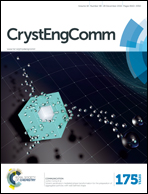Understanding the single-crystal-to-single-crystal solid-state phase transition of dl-methionine†
Abstract
The solid-state phase transition between the low temperature β and the high temperature α forms of DL-methionine was characterised in detail using DSC, SCXRD, thermal stage polarisation microscopy and solid-state NMR. The thermodynamic transition point of the α ↔ β transition of DL-methionine was determined to fall between 306 and 317 K. The transition is kinetically hindered, as is indicated by a large hysteresis. Moreover, the transition rate during cooling is significantly lower than during heating and there is a large temperature region of coexistence. The kinetic barriers involved are lower for single crystals than for powders. DL-Methionine crystals consist of 2D hydrogen-bonded bilayers interconnected by weak Van der Waals interactions. The crystals transform layer-wise, without complete delamination or deterioration, and with a transition front that propagates perpendicular to the layers and a relatively fast transition within one layer. The fast kinetics within the plane of the layers, combined with the faster kinetics in single crystals, indicate that cooperative motion could play a role in this single-crystal-to-single-crystal phase transition.



 Please wait while we load your content...
Please wait while we load your content...